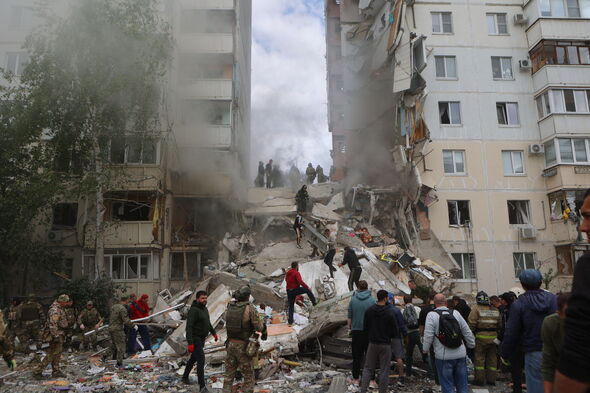Vladimir Putin’s military force dropped four glide bombs intended for attacks on Ukraine‘s Kharkiv region on the Russian village of Shebekino instead last week.
Shebekino is a village in the border region of Belgorod region, which has often borne the burnt of Ukrainian drone strikes. The Belgorod region houses several Russian military bases and training grounds. It has recently been rocked by near-daily explosions as Russian President Vladimir Putin‘s war increasingly hits home.
Independent Russian Telegram channel Astra reported on the farcical news on Monday that four of Russia‘s lethal FAB glide bombs had fallen on the village. At least one of the glide bombs exploded on impact last Friday. There were no casualties reported from the bombings but there was substantial damage to the facade of a residential building.
Vladimir Zhdanov, the head of Shebekino, confirmed on his Telegram channels last Saturday that he had met with residents of households damaged as a result of the “fall of an explosive object” the day before. He did not specify whether the damage was caused by Russian or Ukrainian forces.
The embarrassing incident is far from the first time that Russia has bombed its own territory.
In fact, Astra reported that just a few days before Friday’s self-inflicted bombing, a Russian military aircraft had dropped five FAB-500 and three FAB-250 aerial bombs on the Belgorod region near the villages of Bolshoye Gorodishche, Dobroye, and Polyana. Fortunately, none of the eight of the bombs exploded.
The popular Russian Telegram channel said that over the past three months, Moscow’s forces have dropped at least 46 aerial bombs from their aircraft on Russian soil or Russian-held territories in Ukraine. In May alone, Astra has reported on more than six incidents where bombs accidentally fell on Belgorod.
Russia has sometimes acknowledged the accidental bombings, blaming “an abnormal discharge of ammunition” or claiming it was “emergency releases of aviation munitions”.
A British Ministry of Defence intelligence briefing in January said that the rise in accidental bombings was likely caused by a combination of inadequate training leading to faulty procedures for arming aircraft prior to flights, poor mission execution by aircrew, and crew fatigue. It may also be that the glide bomb modification on some have failed causing them to fall on Russian territory rather than distant Ukrainian targets.
This comes as fighting continues to rage on Ukraine‘s north-eastern frontier near the city of Kharkiv.
The bombs that hit Belogorod were intended to shell Ukrainian villages in Kharkiv and advance the Russian offensive there. Russia is increasingly using cheap but highly destructive glide bombs. More than 200 of them are thought to have been used in just a week to hit Vovchansk in Kharkiv.
Russian forces recently began a summer offensive, grabbing several villages in the region. The WHO’s Jarno Habicht said that 14,000 had fled the fighting in the area.
At an unannounced trip to Kyiv on Tuesday, Germany’s foreign minister Annalena Baerbock urged the West to supply more air defence weapons so that Ukrainians were protected from the “rain of Russian drones and missiles”.
